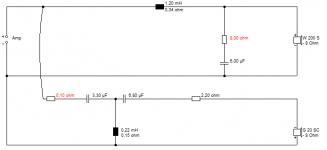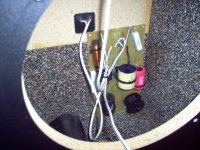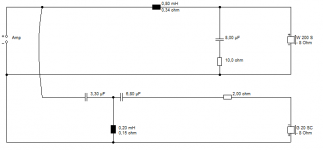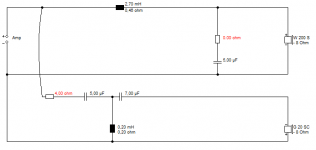Sometimes you just have to ignore the critics, mon ami. 😉
I am working on something similar to you right now with a similar 200mm bass unit to yours. Perhaps we can compare results over the next few days.
I am only concerned that your tweeter is about the right loudness. The 0.1 ohm resistor may have to be replaced with something like 2.2R. It is just there to mark the place where a larger one would go.
The 8 ohm resistor should be about right for your paper bass. It's a guess. I have tried to work with what you have again.
I would guess this speaker has a solid midrange presence delivery with not too much bass. Time will tell. 🙂
I am working on something similar to you right now with a similar 200mm bass unit to yours. Perhaps we can compare results over the next few days.
I am only concerned that your tweeter is about the right loudness. The 0.1 ohm resistor may have to be replaced with something like 2.2R. It is just there to mark the place where a larger one would go.
The 8 ohm resistor should be about right for your paper bass. It's a guess. I have tried to work with what you have again.
I would guess this speaker has a solid midrange presence delivery with not too much bass. Time will tell. 🙂
Attachments
Hi,
Sometimes you have to ignore those that severely overate
the"information" they are providing, its simply your choice.
rgds, sreten.
Sometimes you have to ignore those that severely overate
the"information" they are providing, its simply your choice.
rgds, sreten.
How true. 🙂Hi,
Sometimes you have to ignore those that severely overate
the"information" they are providing, its simply your choice.
rgds, sreten.
Vans60, this circuit is VERY good. My favourite 8" build so far. I used an old cloth surround bass Sony E44 speaker, which had a minimal crossover of 3.3uF on the mylar tweeter and nothing else. Now has a lovely smooth Morel CAT298 tweeter and a proper crossover.
Sounds very nice indeed. It is really pure classic Celestion at heart with a modern soft dome ferrofluid tweeter. I will ramp it up tomorrow when my neighbours aren't sleeping, but I like what I'm hearing.

Attachments
How true. 🙂
Hi, Q.E.D., play spot the amateur, rgds, sreten.
Last edited:
Lol can you two just get a ring, a ref, and allow us to bet on the outcome?
Hi,
I'm the ref😉
I'm accustomed with this sort of debate
 Differents opinions can help me too to find the good solution.
Differents opinions can help me too to find the good solution.Hi,
Sometimes you have to ignore those that severely overate
the"information" they are providing, its simply your choice.
rgds, sreten.
You say that System7 is wrong, but you don't propose anything😕
Have you some "informations" for me about those speakers ?
I don't understand Q.E.D sorry😱
Hi System7,
I'm interresting to try a small inductance with the woofer. Perhaps it can sing higher.
But last days were full of work. I don't try anything😀
Certainly this weekend.
I'm interresting to try a small inductance with the woofer. Perhaps it can sing higher.
But last days were full of work. I don't try anything😀
Certainly this weekend.
You say that System7 is wrong, but you don't propose anything😕
Have you some "informations" for me about those speakers ?
I don't understand Q.E.D sorry😱
Hi,
I too could download the Visaton simulator and start
suggesting stuff based on the wrong drivers but I won't.
Without any information for the original drivers I'd be
shooting in the dark, you need detailed information
to get the integration of a bassmid and tweeter right.
If you have the original x/o circuit but a different tweeter
one can assume its half right. If said x/o has no treble
attenuation resistors, one can assume a that the
original tweeter is a bespoke KEF unit selected
for low sensitivity, typical later KEF practise,
tweeters with relatively small magnets.
Consequently an L-pad on the replacement tweeter
is likely to be needed with the original x/o circuit.
L-pad to the original tweeter impedance if known.
You'll need a few resistors to try different attenuations.
It that doesn't work, or it does work, i.e. its sounds
like its probably near the original intention, but you
don't like it, then "improving" it is a difficult matter.
You can unwind the inductor somewhat and reduce tweeter
attenuation a little at the same time for some fine tuning,
if the basic setup does sound about right but too rich.
Using the best information available is usually the best way.
rgds, sreten.
Use driver polarities according to the x/o circuit.
Last edited:
Hi,
FWIW the original tweeters were a version of the Audax HD100 D25.
They are not the typical DIY version.
They are smaller magnet specials made for Kef by Audax.
My brother has a pair of Coda II's and Cantor II's, the latter
has the same T33 version as the Celeste 3. He confirmed
that they are both different to the D25's in his Spendors.
The SP1068 has a bigger magnet than the SP1081,
but still not as big as the "standard" DIY Audax D25.
Audax TW025A0 HD12x9D25 HD12x8D25 spares and replacement voice coils from Falcon Acoustics, The Leading Supplier of DIY Hifi Components.
I'd assume the original x/o is for a 6 ohm tweeter,
i.e. L-pad the tweeter to 6R input impedance.
rgds, sreten.
FWIW the original tweeters were a version of the Audax HD100 D25.
They are not the typical DIY version.
They are smaller magnet specials made for Kef by Audax.
My brother has a pair of Coda II's and Cantor II's, the latter
has the same T33 version as the Celeste 3. He confirmed
that they are both different to the D25's in his Spendors.
The SP1068 has a bigger magnet than the SP1081,
but still not as big as the "standard" DIY Audax D25.
Audax TW025A0 HD12x9D25 HD12x8D25 spares and replacement voice coils from Falcon Acoustics, The Leading Supplier of DIY Hifi Components.
I'd assume the original x/o is for a 6 ohm tweeter,
i.e. L-pad the tweeter to 6R input impedance.
rgds, sreten.
Hi, that's a constructive answer
My first question on this topic is "who have the specifications for B200 SP1070 ?" because i know it's impossible to simulate with another woofer. If i found those T/S, of course i have provided them to be helped.
I think too that the T33 have a lower Fs than the T3939 because when i use the crossover of the Kef, the Celestion sounds rough.
I can try. I have a lot of resistors. But attenuate him will change the cut frequency ?
Nobody can like this Celestion with this crossover😉It's really too low.
When i say that i don't like, i talk about the woofer wich, with a 2.7mh inductor, have a mid too attenuate and lost his beautiful sound. It's better with a smallest inductor.
I'll try it too.
Thanks a lot for your contribution.
Hi,
I too could download the Visaton simulator and start
suggesting stuff based on the wrong drivers but I won't.
Without any information for the original drivers I'd be
shooting in the dark, you need detailed information
to get the integration of a bassmid and tweeter right.
My first question on this topic is "who have the specifications for B200 SP1070 ?" because i know it's impossible to simulate with another woofer. If i found those T/S, of course i have provided them to be helped.
If you have the original x/o circuit but a different tweeter
one can assume its half right. If said x/o has no treble
attenuation resistors, one can assume a that the
original tweeter is a bespoke KEF unit selected
for low sensitivity, typical later KEF practise,
tweeters with relatively small magnets.
I think too that the T33 have a lower Fs than the T3939 because when i use the crossover of the Kef, the Celestion sounds rough.
Consequently an L-pad on the replacement tweeter
is likely to be needed with the original x/o circuit.
L-pad to the original tweeter impedance if known.
You'll need a few resistors to try different attenuations.
I can try. I have a lot of resistors. But attenuate him will change the cut frequency ?
It that doesn't work, or it does work, i.e. its sounds
like its probably near the original intention, but you
don't like it, then "improving" it is a difficult matter.
Nobody can like this Celestion with this crossover😉It's really too low.
When i say that i don't like, i talk about the woofer wich, with a 2.7mh inductor, have a mid too attenuate and lost his beautiful sound. It's better with a smallest inductor.
You can unwind the inductor somewhat and reduce tweeter
attenuation a little at the same time for some fine tuning,
if the basic setup does sound about right but too rich.
Using the best information available is usually the best way.
rgds, sreten.
Use driver polarities according to the x/o circuit.
I'll try it too.
Thanks a lot for your contribution.
Hi,
FWIW the original tweeters were a version of the Audax HD100 D25.
They are not the typical DIY version.
They are smaller magnet specials made for Kef by Audax.
My brother has a pair of Coda II's and Cantor II's, the latter
has the same T33 version as the Celeste 3. He confirmed
that they are both different to the D25's in his Spendors.
The SP1068 has a bigger magnet than the SP1081,
but still not as big as the "standard" DIY Audax D25.
Audax TW025A0 HD12x9D25 HD12x8D25 spares and replacement voice coils from Falcon Acoustics, The Leading Supplier of DIY Hifi Components.
I'd assume the original x/o is for a 6 ohm tweeter,
i.e. L-pad the tweeter to 6R input impedance.
rgds, sreten.
When i start to think about this project, i search some HD13D34 to use with Davis 20MP8GAW. So i could use the Davis tweeter T26T with the B200. But when i found the Celestion tweeter, in my mind, it was better to associate 2 english speakers. Perhaps it's a mistake but it's too late now.
Cordially.
Hi,
You attentuate the tweeter using two resistors, one in
series one in parallel, keeping the load impedance for
the crossover the same, so the x/o F and Q does
change as attenuation is varied. I reckon use 6R.
L pad calculator - attenuation dB damping impedance decibel loudspeaker speaker voltage divider - sengpielaudio Sengpiel Berlin
e.g. -3dB would be 1.8R series, 15R parallel
assuming the tweeter is 6R and loading is 6R.
The parallel resistor may reduce the effects
of a tweeters impedance peak if it has one.
I wouldn't judge anything until I'd tried the original
crossover circuit with the treble brought down to
match assuming it needs to be brought down.
You can't judge the midrange listening to the
bassmid without the tweeter set about right.
You can't judge a tweeter x/o if its set too loud.
If it sounds horrible then something is wrong,
and it would be hard to say what that would be.
I doubt the original crossover is set quite low,
well low enough to get any decent dome into
any real trouble, but I don't know the tweeter.
rgds, sreten.
You attentuate the tweeter using two resistors, one in
series one in parallel, keeping the load impedance for
the crossover the same, so the x/o F and Q does
change as attenuation is varied. I reckon use 6R.
L pad calculator - attenuation dB damping impedance decibel loudspeaker speaker voltage divider - sengpielaudio Sengpiel Berlin
e.g. -3dB would be 1.8R series, 15R parallel
assuming the tweeter is 6R and loading is 6R.
The parallel resistor may reduce the effects
of a tweeters impedance peak if it has one.
I wouldn't judge anything until I'd tried the original
crossover circuit with the treble brought down to
match assuming it needs to be brought down.
You can't judge the midrange listening to the
bassmid without the tweeter set about right.
You can't judge a tweeter x/o if its set too loud.
If it sounds horrible then something is wrong,
and it would be hard to say what that would be.
I doubt the original crossover is set quite low,
well low enough to get any decent dome into
any real trouble, but I don't know the tweeter.
rgds, sreten.
I wouldn't judge anything until I'd tried the original
crossover circuit with the treble brought down to
match assuming it needs to be brought down.
Of course. The Celeste 3 was a well liked speaker. I was assuming this had been tried already, but if not, below is a reasonable guess what you do with a louder (88dB) tweeter than the original T33.
The woofer will be around Le of 0.8 to 1 mH for this to work. Crossover is around 2.8 kHz which is good at reducing harsh cone breakup from the bass. It is also quite bassy and inefficient. The English sound? 😀
If you use 2.2mH, the bass shunt should be around 2R and 6uF.
Attachments
Hi,
Adding a 4R series resistor for attenuation will also
change the treble x/o's transfer function due to a
large change in the source impedance driving it.
rgds, sreten.
Adding a 4R series resistor for attenuation will also
change the treble x/o's transfer function due to a
large change in the source impedance driving it.
rgds, sreten.
That is true in general, but the reason a simple series resistance will work as well as an L-pad here is that the tweeter filter impedance here is reasonably flat.Hi,
Adding a 4R series resistor for attenuation will also
change the treble x/o's transfer function due to a
large change in the source impedance driving it.
rgds, sreten.
L-pads are fiddly for the DIYer, changing two values. This approach is easier, IMO. 🙂
Whether the response is the same, just a series R will change Qes, which may be audible. Id try both ways, and if no discernable difference, then id use the least components
Hi,
Generally the L-pad arrangement is best, even though it too changes
Qes by the effective series resistance of the Lpad resistors in parallel,
which will be always less than just using a series resistor.
A series resistor pre crossover will also change the filter function,
effectively "damping" the filter and making the response droopier.
If the tweeter is not ferrofluid the parallel resistor helps,
by reducing impedance peaking at the tweeters Fs.
rgds, sreten.
Generally the L-pad arrangement is best, even though it too changes
Qes by the effective series resistance of the Lpad resistors in parallel,
which will be always less than just using a series resistor.
A series resistor pre crossover will also change the filter function,
effectively "damping" the filter and making the response droopier.
If the tweeter is not ferrofluid the parallel resistor helps,
by reducing impedance peaking at the tweeters Fs.
rgds, sreten.
* Manufacturer: KEF
* Model: SP1014
* Piston Diameter = 172.0 mm
* f(s)= 37.68 Hz
* R(e)= 7.52 Ohms
* Z(max)= 59.42 Ohms
* Q(ms)= 5.965
* Q(es)= 0.864
* Q(ts)= 0.755
* V(as)= 56.650 liters (2.001 cubic feet)
* L(e)= 1.20 mH
* n(0)= 0.33 %
* SPL= 87.34 1W/1m
* M(ms)= 23.89 grams
* C(ms)= 0.75 mm/N
* BL= 7.02
* Model: SP1014
* Piston Diameter = 172.0 mm
* f(s)= 37.68 Hz
* R(e)= 7.52 Ohms
* Z(max)= 59.42 Ohms
* Q(ms)= 5.965
* Q(es)= 0.864
* Q(ts)= 0.755
* V(as)= 56.650 liters (2.001 cubic feet)
* L(e)= 1.20 mH
* n(0)= 0.33 %
* SPL= 87.34 1W/1m
* M(ms)= 23.89 grams
* C(ms)= 0.75 mm/N
* BL= 7.02
- Status
- Not open for further replies.
- Home
- Loudspeakers
- Multi-Way
- DIY with Kef and Celestion




